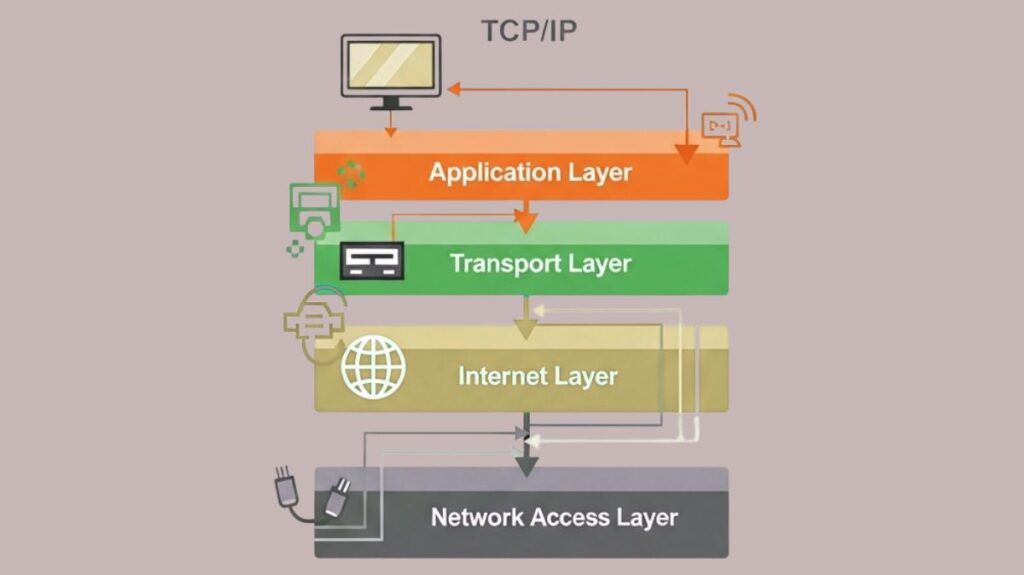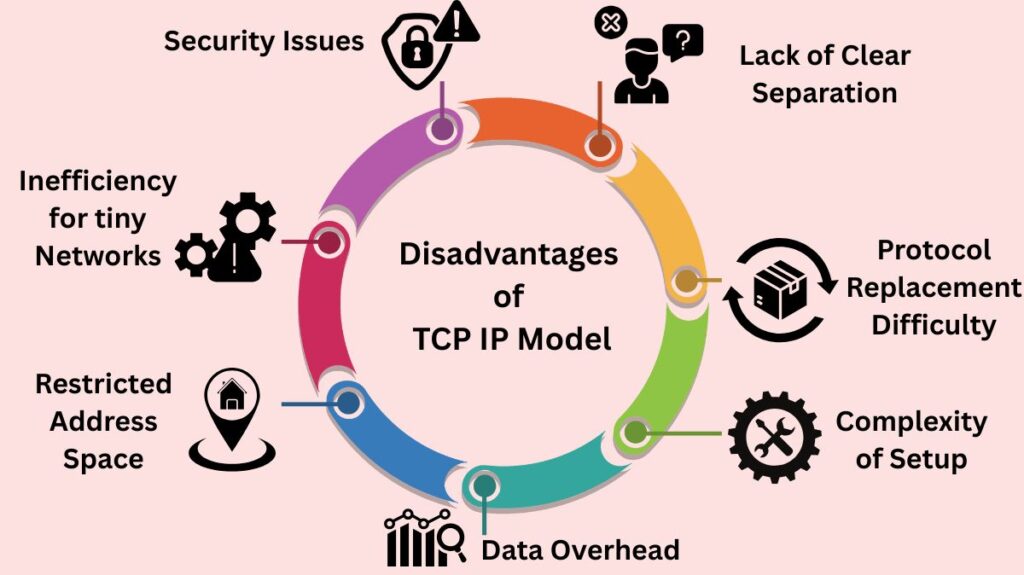This article covered the Transmission Control Protocol/Internet Protocol (TCP/IP) model’s definition, history, and goals, as well as its layers, functions of each layer, key protocols in the TCP/IP framework, how the model works, data encapsulation in TCP/IP, OSI Model vs. TCP/IP, advantages, disadvantages Of TCP IP Model, and key TCP/IP concepts that are displayed below.
TCP/IP protocol model
A key conceptual framework for comprehending how networks, especially the Internet, function is the Transmission Control Protocol/Internet Protocol (TCP/IP) model. It is a reliable and resilient networking model that was first created by the U.S. Department of Defence (DoD) to guarantee data integrity and sustain communications even under dire circumstances. The most widely used networking model and the accepted norm for Internet communications nowadays is TCP/IP.
Origin and Purpose
The TCP/IP architecture was initially created by the U.S. Department of Defence (DoD) in the 1970s for use in ARPANET, the internet’s forerunner. It was intended to guarantee data integrity and sustain connections even in dire circumstances. It serves as a layer of abstraction between the underlying routing and switching infrastructure and internet applications. By dividing data into smaller packets that travel independently and are reassembled at the destination, it primarily aims to guarantee that data transmitted by the sender reaches the recipient’s end securely and accurately.
How the model works
The procedure moves through the levels in a descending direction while sending data (from sender to receiver):
- Application Layer: Uses protocols such as HTTP, FTP, or SMTP to prepare user data.
- Data is divided into chunks by the Transport Layer (TCP/UDP), which guarantees dependable (TCP) or quick (UDP) delivery.
- IP addresses are added, and each packet’s optimal path is determined by the Internet Layer (IP).
- The Link Layer, also known as the Network Access Layer, transforms packets into frames before transmitting them via the actual network.
The procedure moves upwards when data is received (at the destination):
- Link Layer: Rebuilds frames to go on to the next layer after receiving bits from the network.
- Internet Layer: Forwards data to the Transport Layer after verifying the IP address and deleting the IP header.
- Transport Layer: Assembles segments again, verifies that the data is complete, and checks for mistakes.
- Application Layer: Provides the finished data to the appropriate application, such as a web page that appears in the browser.
Layers in the TCP/IP model

Protocols and standards are among the few categories (called levels) into which the TCP/IP architecture divides network operations.
Application Layer
Serves as an interface between software (such as a web browser) and the network, offering services to application software. It outlines the services that apps require, like how web browsers use HTTP to obtain web page content. Activities from the Application, Presentation, and Session layers of the OSI are combined in this layer. It regulates user interface guidelines and establishes protocols for communication between node-to-node applications.
Transport Layer (Host-to-Host Layer)
Protocols for configuring the transmission service level for applications are defined by this layer. In order to address problems such dependable end-to-end communication, error-free delivery, packet sequencing, and data integrity, its main goal is to divide and reassemble data into a single data stream. Because of its support for multiplexing, a single machine with a single IP address can run many sessions at once.
Internet Layer (Network Layer)
This layer is equivalent to the Network layer of the OSI. Routing and giving the higher layers a single network interface are its primary functions. IP specifies distinct logical addresses (IP addresses) for hosts and the routing process, which enables routers to choose the most efficient route for packet delivery to the destination. Regardless of the type of LAN or WAN link, its main objective is to deliver data throughout the whole path from source to destination.
Network Access Layer (Data Link and Physical Layers)
Data interchange between the host and the network is implemented by the Network Access Layer (Data Link and Physical Layers). In addition to managing hardware addressing and outlining the physical connections between networked devices and the media, it specifies the hardware and protocols needed to transport data over a physical network. This layer is comparable to the Physical and Data Link layers of the OSI.
Also Read About Network Topology Types: Bus, Star, Mesh And More Topologies
Important Protocols in the TCP/IP Framework
Application Layer Protocols
- Domain Name System (DNS): Converts hostnames to IP addresses and provides a website’s IP address.
- Dynamic Host Configuration Protocol (DHCP): Automatically gives network configuration information and assigns IP addresses to clients that request them.
- Hypertext Transfer Protocol (HTTP): Defines the format and transmission of messages between web clients and web servers.
- HTTP Secure (HTTPS): A secure variant of HTTP that is frequently used in conjunction with HTTP.
- File Transfer Protocol (FTP): Enables clients and servers to download and upload files. It is focused on connections.
- Cisco IOS images and configuration files are frequently transferred using the Trivial File Transfer Protocol (TFTP), which facilitates quicker, connectionless file transfers.
- Email message sending is made easier via the Simple Mail Transfer Protocol (SMTP).
- Mail clients use Internet Message Access Protocol 4 (IMAP4) and Post Office Protocol 3 (POP3) to gather mail, usually using TCP for transport.
- Telnet: Allows administrators to access a host from a distance.
- Network management systems can monitor devices thanks to the Simple Network Management Protocol (SNMP).
- Clocks on different networks are synchronised by the Network Time Protocol (NTP).
- For safe remote access, use Secure Shell (SSH).
Transport Layer Protocols
- Transmission Control Protocol (TCP): This transport layer protocol is connection-oriented and offers dependable data transfer. It offers multiplexing using port numbers, flow management with a windowing approach, and error recovery.
- The User Datagram Protocol (UDP) is a connectionless transport layer protocol that offers minimal overhead, quicker, and unpredictable data delivery.
Internet Layer Protocols
- Internet Protocol (IP): Specifies the data routing procedure and gives computers unique global addressing. There is no relationship.
- Reachability and service availability are among the error and control messages sent by the Internet Control Message Protocol (ICMP).
- Address Resolution Protocol (ARP): When only the IP address is known, it determines the host’s hardware address (MAC).
- Reverse Address Resolution Protocol (RARP): This method uses a known hardware address to determine an IP address.
Data Link & Physical Layer Protocols
- The most widely used LAN standard for framing and getting data ready for media transmission is Ethernet.
- 802.11 (Wi-Fi): Wireless local area network (WLAN) standards.
Also Read About Data Communication And Networking Technologies Protocols
Data Encapsulation within TCP/IP
Each layer of the TCP/IP paradigm adds its header (and occasionally a trailer for data-link protocols) to the payload that the upper layer has supplied when delivering data. We refer to this procedure as encapsulation. The following terms are used to describe messages at various layers:
- Transport layer is the segment.
- Packet: Network (Internet) layer.
- Frame: Layer of the Data Link.
OSI model vs TCP IP model
The OSI and TCP/IP conceptual frameworks are both crucial for comprehending networks. While TCP/IP protocols are the guidelines that networks now follow, the OSI model is mostly used to illustrate networking principles and troubleshoot issues.
Similarities
- Both models have layers.
- The Application, Transport, and Network layers in both have similar purposes.
- Both presume packet-switched technology.
Differences
- Number of Layers: The popular TCP/IP model has five layers, but OSI has seven (or occasionally four, as in the earlier DoD model).
- Consolidation of Layers:
- The Presentation and Session layers are combined into the Application layer of TCP/IP.
- The Network Access layer (also known as the Link layer) of TCP/IP incorporates the OSI Data Link and Physical layers.
- Transport Layer Reliability: Unlike the OSI Transport layer, which prioritises dependable transport, the TCP/IP Transport layer (more especially, UDP) does not always ensure dependable delivery.
Also Read About How Data Flows Through The OSI Model And It’s Importance
Key TCP/IP Concepts
Connectionless vs Connection-Oriented
- Because TCP is connection-oriented, it necessitates a message exchange (similar to a three-way handshake) prior to data transmission, guaranteeing dependable delivery with flow control and acknowledgements.
- Because UDP is connectionless, it can transport data more quickly and unreliably without the burden of acknowledgements or flow control, making it appropriate for data that is lightweight or has a tight deadline.
Port Numbers
Multiple applications can share a single IP address thanks to port numbers, which are used by both TCP and UDP at the transport layer to uniquely identify the application process transmitting or receiving data.
IP Addressing
IP groupings addresses according to postal codes, making routing easier, and specifies that every host requires a distinct IP address for identification. MAC addresses refer to hardware, whereas IP addresses are software.
TCP/IP is a major topic of the CCNA exam, with an emphasis on how IP networks transfer packets between hosts via LANs and WANs.
Advantages and Disadvantages Of TCP IP Model
Advantages of TCP IP Model
- Interoperability: Promotes compatibility by enabling communication between various computer and network kinds.
- Scalability: Excellent scalability for networks of all sizes, including the internet.
- Standardisation: Founded on open standards and protocols, this ensures that software and devices can coexist without experiencing incompatibilities. It is not under a single company’s control and is nonproprietary.
- Flexibility: Offers a range of data formats, communication channels, and routing protocols. It works with every kind of hardware and operating system.
- Reliability: Offers retransmission capabilities (via TCP) and error-checking for dependable data delivery.
- Practicality: It is frequently used because it is easier to use and more useful than the OSI model.
Disadvantages of TCP IP Model

- Security Issues: Security protocols were introduced later because they were not initially intended to be secure, which may result in vulnerabilities. It is especially susceptible to attacks involving synchronization.
- Inefficiency for tiny Networks: For very tiny networks, the complexity and costs may not be necessary.
- Restricted Address Space: Although IPv6 solves this, the outdated IPv4 system’s restricted address space can cause address exhaustion in large networks.
- Data Overhead: To guarantee dependable transmission, TCP, being a transport protocol, incorporates a substantial overhead.
- Complexity of Setup: It may be difficult to manage and set up.
- Protocol Replacement Difficulty: Changing protocols within TCP/IP is challenging.
- Lack of Clear Separation: It may not be as appropriate for explaining emerging network technologies since it fails to distinguish between the ideas of services, interfaces, and protocols.
Also Read About CCNA Topics And What Is A CCNA Certification In Networking?
